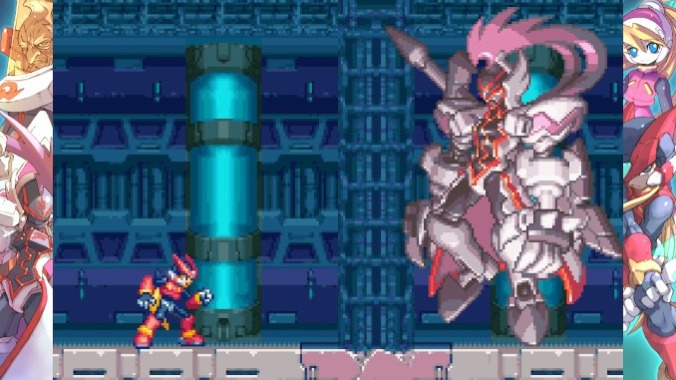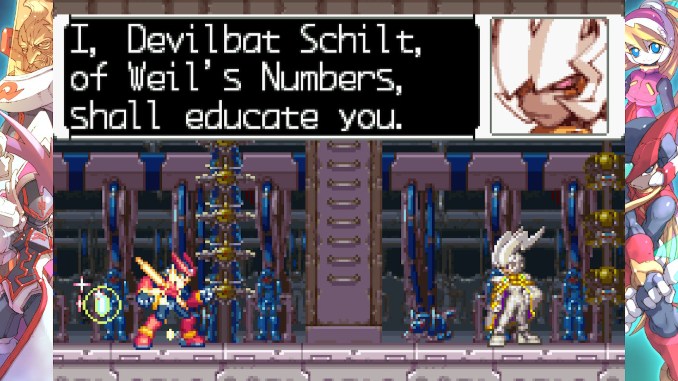20 Years Later, Mega Man Zero 3 Remains Brilliant, Brutal, and Eager to Snap You in Half
Games Features Mega Man
Like many internet discourses, conversations around the history of difficulty in games are weird and scattershot. One of the most common framings is that during some broadly characterized “back in the day,” games were super hard, until all of them became really easy and for babies due to having too much tutorialization or something. But then, in the late aughts, the masacore movement swept in like Gandalf cresting the horizon of Helm’s Deep, as titles like Spelunky and Demon’s Souls made games good and difficult again.
Sure, there are some faint glimmers of truth here. Specifically, as the industry moved away from the coin-guzzling tendencies of the arcades, there became less reason to make games so demonic by default, and as many projects received larger development teams and budgets, it became possible to craft longer experiences that didn’t rely on brutal design to extend playtime by forcing retries. And perhaps most importantly, it became clear to designers that bashing people’s heads in maybe wasn’t the best approach to attract new players. But of course, the previously mentioned simplistic timeline of events elides that even during this supposed “dark age” where games were too easy, there were still plenty of masochistic experiences for those willing to seek them out. A perfect example is the Mega Man Zero series, which lived up to the franchise’s lineage by delivering many, many game over screens.
Inti Creates briskly released all four installments between April 2002 and April 2005 for the Game Boy Advance. They take place in an even bleaker future than the X games, where Zero, previously the co-star, awakens from a centuries-long slumber to find that the world is quite messed up and that his former companion, X, seems to have become a genocidal dictator. Sporting gorgeous pixel art and crushing gameplay that matched the narrative’s aggressively grim setting, these spin-offs were generally well-received at the time. They reached their high point with Mega Man Zero 3, which was released exactly two decades ago in Japan on April 23rd. However, there’s always been one somewhat controversial element to them, MMZ3 included, an aspect loved by some and loathed by others: their difficulty was so imposing that it was borderline mean.
Directly emulating the uncompromising nature of its NES forebears, each installment isn’t afraid to atomize players if they haven’t mastered the basics. Zero is more or less a glass cannon, capable of quickly slicing through foes with his plasma sword, but who can’t tank many hits, which is a problem because the screen is almost always filled with hazards. Levels are stuffed with one-hit-kill traps and enemies who swoop in at a moment’s notice, a circumstance made more trying due to the cramped GBA screen, which would have you squinting to pick out the grainy details of encroaching murder robots.
And, of course, in longstanding Mega Man tradition, the bosses are frequently downright diabolical, requiring memorization, planning, and quick reflexes, or you’ll be treated to an animation that will quickly become familiar: Zero exploding into a supernova of yellow spheres. Whether it’s victory or defeat, these fights are frequently over abruptly, every second white-knuckled as you attempt to discern small tells and land charged slashes when you can.

I vividly remember my introduction to the series with Omega, the first boss of Mega Man Zero 3, a towering Reploid who strikes fear into the heart of all he comes across due to his hulking form and sinister history. When we meet him, he’s tossing around bosses from the previous game like dolls and is framed with a low-angle shot that plays up his imposing form. It’s an encounter that feels like the platonic ideal of these games, requiring knowing exactly where you need to be based on just a few frames of animation. His first attack is one that I still have trouble dodging, a barrage of bouncing lasers that take up the entire screen aside from a few safe points. Afterward is the sequence that’s most seared into my mind, as his gauntlets hover away from his body, one strafing horizontally and the other vertically, as the arena is filled with glowing green rings you must dash under and leap over in a mad game of jump rope.
As I died again and again, being sent back to the beginning of the level as my three lives expired, it made me realize something about myself. I was (and still am) a mean game-loving sicko. As long as things mostly felt “fair,” I was more than willing to dash myself against the rocks of this pixelated torture chamber until I came out the other side victorious.
The main thing that made it worth sticking through the countless deaths is that the Zero games sport some of the slickest, most satisfying movement I’ve encountered in a platformer. The centerpiece is the dash, where our protagonist lowers his profile and boosts forward, leaving an afterimage that was so deeply cool to me at the time that this visual likely imprinted on me at a cellular level and explains why I still spend way too much time watching action cartoons. The dash can be used with no cooldown, cancels into itself, can change directions on a dime, and dramatically boosts your horizontal jump distance, making it feel like cheat codes are permanently turned on. Virtually every other action comes out just as hair-trigger fast, from Zero’s sword slashes to his leaps, making for a game much quicker than its parent series.
In motion, it all looks similar to when a honed speedrunner applies advanced movement techniques in other games, except in this case, it’s the bare minimum needed to survive this hostile space. While the trials here are uncompromising and even a little bit unfair in earlier entries, what makes it all seem achievable is the underlying agility that defines every movement. While there aren’t invincibility frames on the dash, the collision boxes are so closely mapped to models that you can almost hear your character’s pixels scraping against incoming blows as you narrowly avoid damage by the thinnest margin.
I would later learn after playing the rest of the series that the third installment is arguably the best, in large part because its bosses are fair and engaging, its level design cuts down on the leap-of-faith nonsense, and it eases up on other irritating design frictions, such as removing the first game’s terrible lives system where your retries didn’t replenish after hitting a game over screen. It also made cyber elves, these little guys you collect in levels, much more helpful by introducing versions that had persistent passive effects, adding some fun customization that functioned as a pseudo-difficulty setting. The only real downside for the third entry compared to other installments is that the fourth would dramatically improve the dispiriting rating system that hangs over the proceedings by making it so you didn’t need to get a high score to unlock many of the most satisfying abilities. Still, if there’s any game in the series I’m most likely to return to, it’s the third, thanks to its finely-tuned foes and well-balanced challenges.

However, while much of my enjoyment with these games comes from slowly learning their intricacies, the best thing added in the 2020 remaster of the series, Mega Man Zero/ZX Legacy Collection, are the new difficulty settings. Specifically, you can enable checkpoints so you don’t have to start a level over from scratch when you die. In one fell swoop, they solved the tedious debate around whether games like Dark Souls should have difficulty settings: no duh they should, dude. Because just like FromSoftware’s output, which feature lovingly rendered backdrops, there’s more to be enjoyed here than just the thrill of besting seemingly impossible challenges, as found in the impressive pixel art and simple pleasure of nimbly moving around this space. While I personally enjoy getting repeatedly owned by an annoying guy named Devilbat Schilt (the boss names here are terrible) until I can beat him with my eyes closed, I can see the appeal of popping in and quickly gliding through this experience, especially if you’re trying to a high-level understanding of what makes them tick from the collection.
If you want to jump in and experience the peak of this spin-off series, two decades since its release, Mega Man Zero 3 hasn’t lost its edge in the slightest. In fact, it probably better matches the tastes of a modern audience than the one that initially received it. Its bosses are satisfying, its systems are more cohesive than those of its predecessors, and most of all, it controls like a dream. Having played an unreasonable number of games in the interim, I’ve still never encountered another platformer that plays quite like this: Zero’s dexterous movements come out so quickly that it feels like the game system is directly tethered to your cerebral cortex. It all makes for a compelling, brutal experience that would likely appeal to a new generation of degenerate thrill-seekers brought up on punishing roguelikes and dodge-rolling duels, and that is quite accessible to these folks due to the great remaster collection. While the Mega Man Zero games will almost certainly remain dormant, and their unique feel with it, it’s good to know a fresh batch of kindred sickos are hopefully on their way to experiencing having Omega crush them into dust for the first time.
Elijah Gonzalez is an assistant Games and TV Editor for Paste Magazine. In addition to playing and watching the latest on the small screen, he also loves film, creating large lists of media he’ll probably never actually get to, and dreaming of the day he finally gets through all the Like a Dragon games. You can follow him on Twitter @eli_gonzalez11.